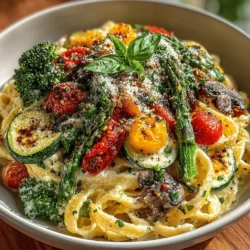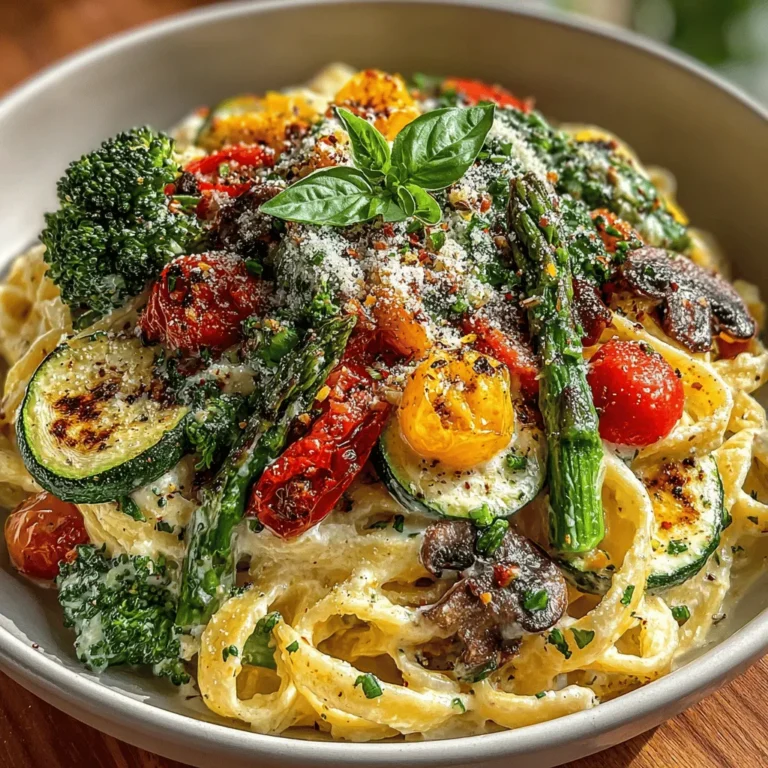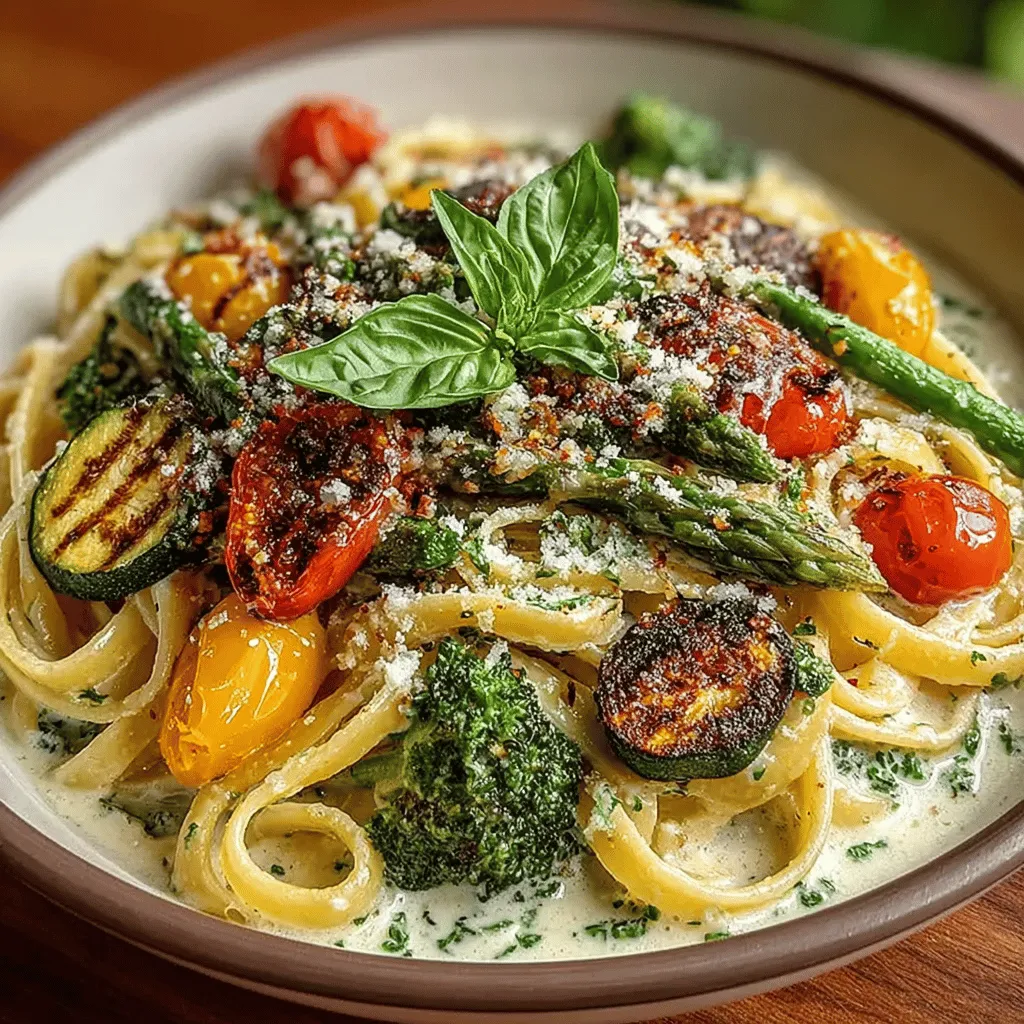Introduction: The Essence of Spring in Every Bite
As the chill of winter fades and the world awakens with vibrant colors, spring brings forth an array of fresh produce and a renewed sense of culinary creativity. One of the most delightful ways to celebrate this season is through a bowl of Creamy Pasta Primavera. This dish encapsulates the very essence of springtime, boasting a medley of colorful vegetables tossed with creamy pasta that is both visually appealing and nourishing.
Pasta Primavera, which translates to “spring pasta,” is a classic Italian dish that highlights the best of seasonal vegetables. The combination of fresh, crisp produce and a rich, creamy sauce creates a harmonious balance that is perfect for family dinners or special occasions. Not only does it offer a feast for the eyes, but it also serves as a wholesome meal, packed with vitamins and minerals from the vegetables. In this article, we will delve into the ingredients that make up this delightful recipe, the preparation steps involved, and the overall experience of relishing this seasonal favorite.
Understanding the Ingredients: A Culinary Palette of Freshness
The foundation of any great recipe lies in its ingredients, and Creamy Pasta Primavera is no exception. The dish is built upon a base of pasta complemented by a vibrant selection of fresh vegetables. Each ingredient contributes to the overall flavor profile and texture, creating a well-rounded and satisfying meal.
Choosing the Right Pasta for Your Primavera Experience
The choice of pasta in your Primavera can significantly influence the dish’s texture and overall experience. While traditional recipes often call for fettuccine, you can experiment with various types of pasta to find the perfect match for your palate.
– Fettuccine: This flat, ribbon-like pasta holds onto creamy sauces beautifully, allowing every bite to be rich and satisfying.
– Spaghetti: A classic choice, spaghetti offers a delightful chewiness that pairs well with the sauce and vegetables.
– Penne: The tubular shape of penne allows it to trap pieces of vegetables and sauce, ensuring a balanced bite.
Ultimately, the choice of pasta will depend on personal preference and the texture you wish to achieve in your dish. Regardless of the type you select, the key is to cook it al dente for the best results.
Fresh Vegetables: The Star Players of the Dish
The true charm of Creamy Pasta Primavera lies in the vibrant array of fresh vegetables that take center stage. Each vegetable not only adds color but also brings its unique flavor and texture to the dish. Here are the standout ingredients that contribute to this springtime delight:
– Zucchini: This summer squash is a versatile ingredient that adds a tender crunch and absorbs the flavors of the sauce beautifully.
– Bell Peppers: Available in a rainbow of colors—from red and yellow to green and orange—bell peppers contribute sweetness and a crisp texture, enhancing the dish’s visual appeal.
– Cherry Tomatoes: Their juiciness adds a burst of flavor that complements the creaminess of the sauce, creating a delightful contrast.
– Asparagus: With its unique flavor and satisfying crunch, asparagus not only adds nutritional value but also elevates the dish’s gourmet appeal.
– Broccoli: This nutrient-dense vegetable provides a robust texture and a wealth of vitamins, making it a healthful addition to the dish.
– Peas: These little green gems bring a sweet burst of flavor and a vibrant green hue, enhancing the overall aesthetic of your Pasta Primavera.
Incorporating a variety of vegetables not only makes the dish more colorful but also ensures a wide range of nutrients, making it a wholesome meal option.
The Creamy Sauce: A Decadent Touch
No Pasta Primavera would be complete without its luxurious creamy sauce that ties all the elements together. The key ingredients in this sauce are heavy cream and Parmesan cheese, which create a rich, velvety texture that envelops the pasta and vegetables.
– Heavy Cream: This is the base of the sauce, providing a luscious mouthfeel that elevates the dish to indulgent levels.
– Parmesan Cheese: Known for its sharp and nutty flavor, freshly grated Parmesan adds depth and richness to the sauce, while also helping it to thicken perfectly.
To brighten the dish and balance the creaminess, the addition of lemon juice and zest is essential. The acidity from the lemon cuts through the richness of the cream, adding a refreshing burst of flavor that enhances the overall experience. This careful balance of flavors is what makes Creamy Pasta Primavera truly special.
Preparation Steps: Crafting Your Pasta Primavera
Creating the perfect Creamy Pasta Primavera is a straightforward process that can be enjoyed by cooks of all skill levels. Follow these simple steps to bring this delightful dish to life:
1. Gather Your Ingredients: Begin by assembling all necessary ingredients, including your chosen pasta, fresh vegetables, heavy cream, Parmesan cheese, and lemon.
2. Prepare the Vegetables: Wash and chop the vegetables into bite-sized pieces. This ensures even cooking and allows each vegetable to shine.
3. Cook the Pasta: In a large pot, bring salted water to a boil. Add your chosen pasta and cook according to package instructions until al dente.
4. Sauté the Vegetables: In a separate large skillet, heat a drizzle of olive oil over medium heat. Add the chopped vegetables and sauté until they are tender yet still vibrant in color. This step enhances their natural sweetness and brings out their flavors.
5. Create the Creamy Sauce: Once the vegetables are cooked, reduce heat and stir in the heavy cream. Allow it to simmer gently, then mix in the grated Parmesan cheese, stirring until the sauce is smooth and creamy.
6. Combine Pasta and Sauce: Drain the cooked pasta and add it to the skillet with the creamy sauce and vegetables. Toss everything together, allowing the pasta to soak up the flavors of the sauce.
7. Finish with Lemon: Just before serving, squeeze fresh lemon juice over the pasta and sprinkle with lemon zest for an invigorating touch that highlights the freshness of the dish.
With these initial steps, you are well on your way to creating a vibrant and delicious Creamy Pasta Primavera that embodies the essence of spring in every bite. In the following sections, we will dive deeper into tips for perfecting your dish and the best ways to serve and enjoy this seasonal favorite.
Cooking Pasta Al Dente: The Perfect Texture
Achieving the ideal pasta texture is fundamental to making a delightful Pasta Primavera. Cooking pasta al dente, which means “to the tooth” in Italian, ensures that your pasta maintains a slight firmness in the center. This not only enhances the overall texture of your dish but also allows the pasta to hold onto the sauce better, resulting in a more flavorful experience.
To cook pasta al dente, follow these simple steps:
1. Choose Your Pasta Wisely: Opt for high-quality pasta, whether it’s penne, fusilli, or spaghetti. Each shape offers a unique texture that can complement the creamy sauce and vegetables.
2. Salt Your Water: Use a generous amount of salt in the boiling water—about one tablespoon per gallon. This seasoning infuses the pasta with flavor as it cooks.
3. Timing is Everything: Refer to the cooking instructions on the pasta package, but start tasting your pasta 1-2 minutes before the suggested cooking time. You want it to be tender yet firm when bitten.
4. Reserve Pasta Water: Before draining, save about a cup of the starchy cooking water. This liquid is a goldmine for adjusting the sauce’s consistency and enhancing its creaminess.
Sautéing the Aromatics: Building Flavor
The base of any great dish often begins with the aromatics. In this Creamy Pasta Primavera, sautéing onions and garlic is crucial as they infuse the dish with depth and richness. Here’s how to do it:
1. Heat the Oil: In a large skillet, heat about two tablespoons of olive oil over medium heat. The oil should shimmer but not smoke.
2. Add Onions: Start by adding finely chopped onions. Sauté them for about 3-4 minutes until they become translucent and begin to soften.
3. Incorporate Garlic: Add minced garlic to the skillet and sauté for an additional minute. Garlic cooks quickly and can burn easily, so keep an eye on it. When fragrant, it’s time to move on to the next step.
This combination of onions and garlic creates a flavorful foundation that will elevate the dish, providing a savory backdrop for the vibrant vegetables to shine.
Vegetable Medley: Timing is Key
One of the hallmarks of Pasta Primavera is the vibrant medley of vegetables that contribute both visual appeal and nutritional value. However, timing is essential to ensure that each vegetable retains its unique texture and flavor. Here’s how to do it effectively:
1. Stagger Your Additions: Start with vegetables that take longer to cook, such as bell peppers and zucchini. Add them to the skillet after the garlic has sautéed.
2. Follow with Quick-Cooking Veggies: After about 3-4 minutes, when the aforementioned vegetables begin to soften, add quicker-cooking vegetables like cherry tomatoes and asparagus. These vegetables should only need about 2-3 minutes in the pan.
3. Final Touches: Lastly, add leafy greens like spinach or kale. These should be incorporated just before you finish cooking the pasta, allowing them to wilt slightly without losing their vibrant color.
By adding vegetables at different times, you ensure that each retains its crunch and flavor, creating a delightful contrast against the creamy sauce.
Creating the Creamy Sauce: The Art of Blending
The creamy sauce is the heart of your Pasta Primavera, and getting it just right is crucial. Here are some tips for making a perfect sauce:
1. Start with Cream: In the same skillet you used for the vegetables, add about 1 cup of heavy cream. Allow it to simmer gently over low heat.
2. Add Cheese: Stir in about half a cup of freshly grated Parmesan cheese. This not only thickens the sauce but also adds a depth of flavor. Keep stirring until the cheese is fully melted and the sauce is creamy.
3. Adjust Consistency: If the sauce seems too thick, gradually add a bit of the reserved pasta water. This starchy liquid helps to achieve the ideal creamy consistency while ensuring the sauce adheres to the pasta.
4. Flavor Balance: Taste the sauce and add salt, pepper, and a pinch of Italian seasoning to enhance the flavor. A squeeze of fresh lemon juice can also brighten the sauce, giving it a fresh finish.
Seasoning to Perfection: The Finishing Touch
Seasoning is key to elevating any dish, and your Creamy Pasta Primavera is no exception. Here’s how to make sure your dish is perfectly seasoned:
1. Taste as You Go: Always taste your sauce and vegetables as you cook. This gives you a sense of how much salt and pepper to add.
2. Balance Flavors: Use kosher salt for a cleaner taste and freshly ground black pepper for warmth. Italian seasoning can provide a blend of herbs that complements the dish beautifully. Start with small amounts and gradually increase until you achieve the desired flavor.
3. Garnish Wisely: Once you’ve combined the pasta with the sauce, finish with a sprinkle of freshly chopped basil or parsley for a pop of color and freshness. Additional Parmesan on top will not only enhance the flavor but also create an appealing presentation.
Combining and Serving: The Final Steps
Now that your pasta, vegetables, and sauce are ready, it’s time to bring everything together:
1. Combine Pasta and Sauce: Add the drained pasta to the skillet with the creamy sauce and vegetables. Toss everything together over low heat, ensuring that the pasta is thoroughly coated.
2. Presentation Matters: Transfer the Pasta Primavera to a large serving bowl or individual plates. A beautiful presentation can elevate the dining experience.
3. Final Garnishes: Top with extra grated Parmesan and a sprinkle of fresh herbs. A drizzle of olive oil can also add a finishing touch.
Serve your Creamy Pasta Primavera warm, and let the colors and textures speak for themselves.
Nutritional Benefits: Why Pasta Primavera is a Healthy Choice
Pasta Primavera is not just a feast for the eyes; it’s also packed with nutritional benefits. Here are some reasons why this dish is a wholesome choice:
1. Vegetable Richness: Incorporating a variety of seasonal vegetables means you’re getting a range of vitamins and minerals. From vitamin A in bell peppers to fiber from broccoli, each bite is a nutritional powerhouse.
2. Balanced Meal: This dish offers a balance of carbohydrates from pasta, protein from cheese, and healthy fats from olive oil, making it a well-rounded meal.
3. Customizable Health: You can easily make this dish even healthier by opting for whole-grain pasta or adding lean proteins like grilled chicken or shrimp, making it suitable for everyone.
Culinary Variations: Making Pasta Primavera Your Own
One of the most delightful aspects of Pasta Primavera is its versatility. Here are a few ways to customize the dish to suit your tastes:
1. Experiment with Vegetables: While the classic recipe features bell peppers, zucchini, and asparagus, feel free to experiment. Broccoli, snap peas, or even roasted eggplant can add unique flavors.
2. Protein Additions: For a heartier meal, consider adding grilled chicken, shrimp, or even chickpeas for a vegetarian protein boost. These additions will make your dish more filling while enhancing its flavor profile.
3. Herb Variations: Swap out basil for fresh thyme, oregano, or parsley to change the aromatic experience of your dish. Each herb brings its own character to the meal.
Cultural Connection: The History of Pasta Primavera
Pasta Primavera has an interesting history that reflects its evolution within Italian cuisine. Originating in the mid-20th century, the dish is believed to have been created in New York City, drawing inspiration from Italian culinary traditions. The word “primavera” means “spring” in Italian, which is fitting as the dish celebrates the freshness of seasonal vegetables.
Over the years, Pasta Primavera has transitioned from a simple dish of pasta and vegetables to a creamy, rich version that many have come to love. Its adaptability has made it a staple in many households, symbolizing the beauty of fresh ingredients and the joy of seasonal cooking.
Conclusion: Savoring Spring with Every Bite
Creamy Pasta Primavera is a celebration of spring’s bounty, bringing together a vibrant array of vegetables enveloped in a rich, creamy sauce. Each bite encapsulates the freshness and vibrancy of the season, making it a delightful addition to your culinary repertoire.
Whether you’re hosting a dinner party or enjoying a cozy meal at home, this dish not only tantalizes the taste buds but also nourishes the body. Embrace the flavors of spring and savor the joy of cooking with fresh, seasonal produce. Enjoy this culinary journey and let the beauty of spring grace your table with every delicious bite.


